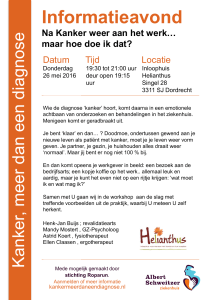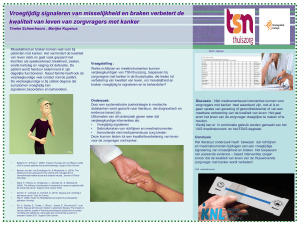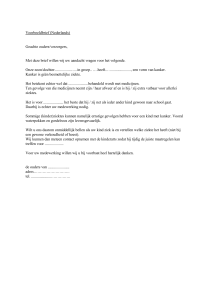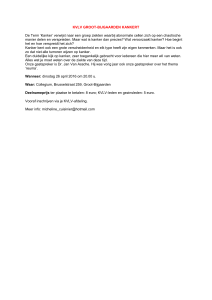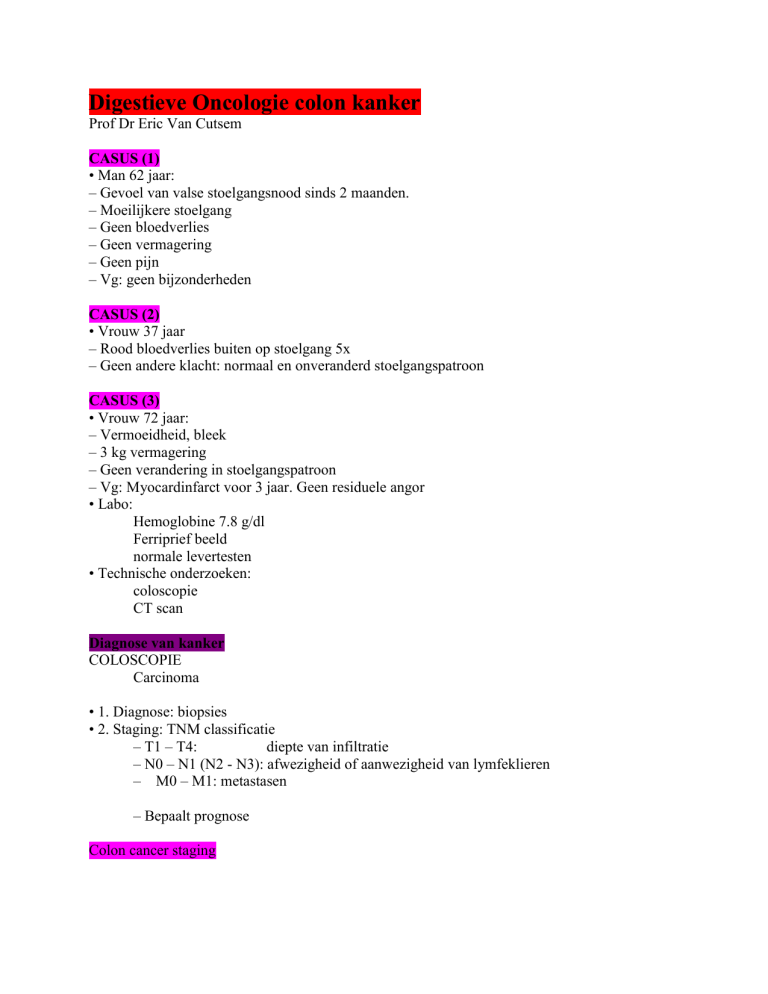
Digestieve Oncologie colon kanker
Prof Dr Eric Van Cutsem
CASUS (1)
• Man 62 jaar:
– Gevoel van valse stoelgangsnood sinds 2 maanden.
– Moeilijkere stoelgang
– Geen bloedverlies
– Geen vermagering
– Geen pijn
– Vg: geen bijzonderheden
CASUS (2)
• Vrouw 37 jaar
– Rood bloedverlies buiten op stoelgang 5x
– Geen andere klacht: normaal en onveranderd stoelgangspatroon
CASUS (3)
• Vrouw 72 jaar:
– Vermoeidheid, bleek
– 3 kg vermagering
– Geen verandering in stoelgangspatroon
– Vg: Myocardinfarct voor 3 jaar. Geen residuele angor
• Labo:
Hemoglobine 7.8 g/dl
Ferriprief beeld
normale levertesten
• Technische onderzoeken:
coloscopie
CT scan
Diagnose van kanker
COLOSCOPIE
Carcinoma
• 1. Diagnose: biopsies
• 2. Staging: TNM classificatie
– T1 – T4:
diepte van infiltratie
– N0 – N1 (N2 - N3): afwezigheid of aanwezigheid van lymfeklieren
– M0 – M1: metastasen
– Bepaalt prognose
Colon cancer staging
ECHOENDOSCOPIE (Endoscopic Ultrasound = EUS)
RECTAL CANCER: EUS T3N0
CAT scan van lever
Epidemiologie
Stadium van colon kanker op het ogenblik van de diagnose in Europa
Epidemiology of Colorectal Cancer Europe
>370,000 patients in Europe develop CRC each year;
>50% develop advanced disease; >200 000 deaths/year
Flanders: > 4000 new cases per year
Lifetime Probability of Developing Cancer, by Site, Men, US, 1998-2000
Site
Risk
All sites
1 in 2
Prostate
1 in 6
Lung & bronchus
1 in 13
Colon & rectum
1 in 17
Urinary bladder
1 in 29
Non-Hodgkin lymphoma
1 in 48
Melanoma
1 in 55
Leukemia
1 in 70
Oral cavity
1 in 72
Kidney
1 in 69
Stomach
1 in 81
Lifetime Probability of Developing Cancer, by Site, Women, US, 1998-2000
Site
Risk
All sites
1 in 3
Breast
1 in 7
Lung & bronchus
1 in 17
Colon & rectum
1 in 18
Uterine corpus
1 in 38
Non-Hodgkin lymphoma
1 in 57
Ovary
1 in 59
Pancreas
1 in 83
Melanoma
1 in 82
Urinary bladder
1 in 91
Uterine cervix
1 in 128
Oorzaken van colonkanker
Erfelijke factoren:
– erfelijke syndromen:
* FAP,
* HNPCC syndroom
– familiale belasting
Omgeving
– Voeding:
te veel vet,
tekort aan groenten & fruit,
onvoldoende vezels,
te weinig calcium
en vitamines
– Overgewicht
– Roken
– Gebrek aan lichaamsbeweging.
Colorectale kanker: risicogroepen
FH: familial history;
IBD: inflammatory bowel disease;
FAP: familial adenomatous polyposis syndrome;
HNPCC: Hereditary Non Polyposis Colon Cancer Syndrome
Colon cancer: incidence according to age and sex
Sequence of molecular defects in tumorigenesis
Adenoma-Carcinoma sequens
Flat adenoma: Man 60 jaar
Sigmoid colon 4 mm
Tubulair adenoma met ernstige dysplasie
1. APC: the gatekeeper = poortwachter
Old age of onset: solitary
Young age ! multipel
Hereditary CRC: Familial Adenomatous Polyposis syndrome
FAP : Familial Adenomatous Polyposis
= Autosomal dominant Mutation in APC gene
Adenomatous Polyposis Coli Gene
Familiale Adenomateuze Polyposis syndroom
FAP syndroom: rectale adenomas ~ follow up elke 6 maanden
Autosomal dominant
incidence
penetrance
gene
Molecular mechanism
+, MYH
1 in 10000
100%
APC, MYH
Tumor supressor
Fenotypic variability
Neomutations
Mean age first CRC
Intestinal
Other cancers
Benign Alterations
+
30%
42 year FAP
>55 year AFAP
>100 adenomatous polyps
>20 in AFAP
Duodenum
Thyroid
Ampulla of Vater
Pancreas
Liver
Brain
CHRPE (=congenital hypertrophy of the retinal pigment)
Desmoids 15%
osteomas
Epidermoid cysts
Duodenal adenoma in FAP
• sessile
• +/- 90% of FAP
• 4% duodenal cancer
• leading cause of death in colectomized patients
Genetische Test bij FAP
Predictieve test voor at-risk personen
– via Centrum Menselijke Erfelijkheid
– Genetische en Psychosociale counselling
Management FAP
• Clinical diagnosis:
– >100 colonic adenomas - FAP
– >10 colonic adenomas - AFAP
• Endoscopy:
– Colo / sigmoido annually, starting age10-12
– Gastroduodenoscopy every 1-3 years, starting age 25-30
• Treatment:
– Colectomy, between ages 15-25 , ileorectal or ileoanale anastomosis with pouch
• Follow-up:
– Follow-up rectum after IRA every 6 mo
– Follow-up pouch after IAA every 6-12 mo
– Endoscopy upper G.I. tract, every 3 years
2. Defective DNA repair and HNPCC or Lynch syndrome
HNPCC = Hereditary non-polyposis colorectal cancer
Microsatellite Instability (MSI)
Due to defective DNA Mismatch Repair( hMSH2,hMLH1, …), DNAalterations are no longer
Repaired
Incidence
Prevalence MSI
HNPCC Cancer
1/500
95 %
Sporadic Cancer
1/20
13-17%
• solitair of synchroon
• rechtszijdig
• snel evolutief
• 80-90% life time risk
• Microsatelliet instabiliteit
Amsterdam Criteria voor HNPCC
• Minstens drie familieleden met histologisch bewezen colorectale kanker (Aantal)
• Eén ervan moet een eerstegraadsverwante zijn van de overige twee.
Twee opeenvolgende generaties moeten aangetast zijn. (Verwantschap)
• Bij één van de verwanten, moet colorectale kanker aanwezig zijn voor de leeftijd van 50
jaar (Leeftijd)
Uitbreiding klinische criteria HNPCC
• Modified Amsterdam Criteria
– kleine families, 2 CRC, ouder en kind met, waarvan één <55jaar
– indien 2 CRC bij eerstegraadsverwanten, een derde familielid met endometrium of andere
geassocieerde kanker
• Young Age At Onset
– Diagnose van CRC onder de leeftijd van 40 jaar, die verder niet voldoet aan Ams of Mod
Ams
• Bethesda
1. Amsterdam criteria positief
2. Twee HNPCC geassocieerde kankers
3. CRC < 40 jaar en eerstgraadsverwante met CRC of HNPCC geassocieerde kanker
4. CRC of endometriumkanker < 45 jaar
5. Rechtszijdig CRC, < 45 jaar ongedifferentieerd patroon
6. CRC zegelringtype <45 jaar
7. adenomas < 40 jaar
Autosomaal dominant
incidence
penetrance
genes
Molecular
Fenotypic variability
Proportion of all crc
Mean age first crc diagnosis
+
1 in 2000 (4000)
60-90% synchronous and metachronous tumors
hMSH2,hMLH1,hPMS1,hPMS2, hMSH6, hMSH3
DNA Repair
+
2-3%
45 years
Cumulative life time risk-HNPCC carriers
Genetische Test bij HNPCC
Faze 1:
• Analyse van Microsatelliet Instabiliteit op vers of paraffine tumor materiaal
(cfr moeilijkheden klinische criteria)
TUMORMATERIAAL
• Immuunhistochemie voor eiwitexpressie hMSH2 en hMLH1
TUMORMATERIAAL
• Mutatieanalyse bij Aangetaste Persoon op bloedstaal
– hMSH2, hMLH1, hMSH6
– gem 6-12 maand
– 60% mutatie gevonden
BLOEDSTAAL
Faze 2:
• Predictieve test voor at-risk personen
– via Centrum Menselijke Erfelijkheid
– Genetische en Psychosociale counselling
Beleid bij Hereditary non-polyposis colorectal cancer syndrome
• Preventieve Onderzoeken:
– Totale Coloscopie om de twee jaar
– Vanaf 25 jaar
– Gynecologisch onderzoek met Intravaginale Echografie en CA 125 bepaling, jaarlijks
– Vanaf 30 jaar
– indien volgende tumoren voorkomen, vanaf 35 jaar:
– Gastroscopie om de twee jaar
– Echo blaas en nieren en urine cytologie, jaarlijks
• Behandeling
– Prophylactische Colectomie? Hysterectomie?
FAP versus HNPCC
Colorectal cancer: Hereditary and Familial forms
Familial forms
Familial history
no crc in family
1 first degree relative with crc
1 first degree relative with crc and
2 second degree relatives with crc
1 first degree relative with crc under 45 y
2 second degree relatives with crc
HNPCC carrier
FAP carrier
life time risk CRC
2-6%
6%
8%
10%
17%
80%
100%
Surveillance Intervals after adenoma/carcinoma
Surveillance Recommendations
Baseline Finding
Interval
1-2 Tub Adenoma <1cm
5 yrs or more
Advanced adenoma
3 yrs
>1cm;Villous;HGD;
>3 tubular adenomas
Cancer
1 yr
Baseline exam: Adequate preperation;
complete examination to caecum
Behandeling van kanker
• Heelkunde:
– Vaak basis van de behandeling (soms endoscopisch)
Rechter hemicolectomie
Colon transversum resectie
Linker hemicolectomie
Sigmoidresectie
• Radiotherapie:
– kan kanker helpen genezen
– Palliatief: pijn
• Chemotherapie:
– kan kanker helpen genezen
– Intraveneus or oraal
• Behandeling door multidisciplinair team van experten
• Chemotherapie of radiotherapie voor gemetastaseerde ziekte
• Chemotherapie of radiotherapie in adjuvante or neoadjuvante setting om de overleving te
verlengen of de kans op genezing te vergroten
Chemotherapie
• Cytotoxische chemotherapie (‘klassieke chemotherapie’)
• Hormonotherapy: eg borst kanker, prostaat kanker, endocriene tumoren
• Biologische geneesmiddelen gericht tegen een specifiek doelwit (target)
• Immunotherapie
• Combinatie
Targets of Cancer Therapy
1. Growth factors
2. Growth factor receptors
3. Adaptor proteins
4. Docking proteins/binding proteins
5. Guanine nucleotide exchange factors
6. Phosphatases and phospholipases
7. Signaling kinases
8. Ribosomes
9. Transcription factors
10. Histones
11. DNA
12. Microtubules
The
angiogenic switch in tumours
Small tumour (1–2mm)
• Avascular
• Dormant
Larger tumour
• Vascular
• Metastatic potential
Angiogenic switch Results in overexpression of pro-angiogenic signals, such as VEGF


